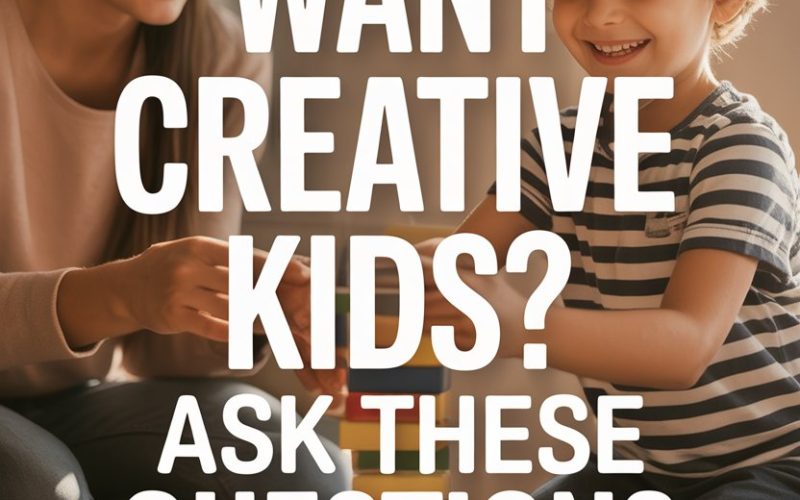What if the difference between a child who colors inside the lines and one who turns the lines into a dragon is just a matter of the right questions?
Parenting is packed with things we’re told to do—feed them, keep them alive, steer them clear of marker-based wall art.
But what if the real magic is hiding in the questions we ask, not just the instructions we give?
Ready to spark your child’s creativity without needing glitter in every crevice of your sofa? Here’s how the right questions can change the game.
Why Questions Matter More Than Answers
Adults love answers. Kids? They live for questions.
Curiosity is their default setting. Harvard’s Project Zero has found that kids who are prompted with open-ended questions develop more flexible thinking skills and stronger problem-solving chops.
That’s because questions open up possibilities, invite stories, and make mistakes less scary. Suddenly, there’s no single “right” answer. Just a big old playground for the mind.
Swap “What Did You Do Today?” For “What Surprised You Today?”
The classic after-school interrogation—“What did you do today?”—usually yields a monosyllabic “Nothing.” (Spoiler: this is a lie. There’s always something, especially if Timmy’s involved.)
Instead, try: “What surprised you today?” Now you’re fishing in richer waters. Kids start scanning their memories for the unexpected, the sideways moments, the things that made them laugh or gasp.
This primes their brains to notice (and value) novelty, which is the home base of creativity.
“Did anything today make you feel curious?” can work wonders, too. Just wait for the wild stories.
Ask “What If?”… And Mean It
“What if” is the original creativity starter pistol. What if your cat could talk? What if rain fell upwards? What if your dinner grew legs and ran out the door before you ate it?
A 2018 study from the Journal of Experimental Child Psychology showed that children exposed to more hypothetical questions displayed greater creative thinking in both storytelling and problem-solving.
You might get answers like, “We’d need to invent ceiling umbrellas,” or, “I’d chase my dinner with a net.” But that’s the point.
You’re giving kids permission to leave the ordinary behind and build worlds out of thin air.
Try swapping in “What would happen if…” during bedtime stories, car rides, or any time you can see the screens beckoning.
Encourage Silly Solutions
“Can you think of three ways to solve this—even if they’re a bit silly?” This question is magic. It tells kids that wild, impractical ideas aren’t just tolerated—they’re celebrated.
Need proof? IDEO, the design company famous for their out-of-the-box culture, starts every brainstorm with a “bad ideas only” round. The goofier, the better. Then, they sift for buried gems.
When your child gets stuck (“I can’t build a tower taller than the dog!”), encourage bananas thinking. “What’s the silliest way you could do it?”
Suddenly, they’re taping LEGO bricks to the dog (let’s call that a teaching moment) or balancing blocks with kitchen spoons. The goal isn’t the finished tower—it’s the process of stretching possibility.
Flip the Question Back to Them
Kids are used to getting quizzed by adults. But when you ask, “What do you think?”—and actually pause for the answer—you create space for their ideas to grow.
Next time your child asks, “Why is the sky blue?” try, “What do you think?” before launching into light scattering and refracted wavelengths.
Their answers might be scientifically dubious, but you’re demonstrating that their thinking is valued, not just their memorization skills.
A University of California study found that kids who get these “turnaround” questions are more likely to stay curious, confident, and self-motivated in learning.
Dig Deeper Than “Why?”
“Why did you draw a banana in a tutu?” It’s a good start. But push past the initial “I don’t know” with nudges like, “Tell me more about this tutu. Where did the banana find it?” or “What happens next in your banana’s story?”
Questions that build on each other mimic the way creative thinking works: one strange thing leads to another, and suddenly you’re three steps removed from reality—in the best way possible.
This layering of ideas stretches their imagination like a bungee cord.
Invite your child to keep building. “What would the banana’s friends wear?” “Where are they all going?” Suddenly, you’re co-writing the next bestselling picture book.
Empower With “How Might You…?”
Asking, “How might you fix this?” is a nudge toward design thinking—a process that’s not just for engineers but for anyone who wants to solve problems creatively.
The “how might you” phrasing does something subtle: it assumes your child can figure it out.
It’s not “Can you fix this?” (which can sound like a pop quiz) but “How might you?”—which invites brainstorming, risk-taking, and mistakes.
Try it during craft disasters, bedtime logistics, or even when negotiating screen time. “How might you get ready for bed and still have time for one more chapter?”
You may be surprised at the creative negotiations children come up with (some more bedtime-friendly than others).
Ask About Different Perspectives
“Can you tell the story from someone else’s view?” At first, you might get a blank stare. But push a little further: “How would the goldfish tell what happened at breakfast?” “What would your shoes say about today’s walk?”
This practice builds empathy and flexible thinking—skills that creativity and good citizenship share.
The Harvard Center on the Developing Child calls this “perspective taking,” and it’s linked to everything from storytelling skills to conflict resolution.
If your child gets stuck, try modeling it. You narrate breakfast as the goldfish, and watch their face light up as they join in.
Encourage Wonder, Not Just Right Answers
Parents are wired to praise correct answers. But “Wow, I never thought of that!” can be even more powerful. Wonder is the fuel of creativity, and it’s contagious.
Try injecting wonder into ordinary moments. “What do you notice about that spider’s web?” or “Why do you think trees lose their leaves?”
Resist the urge to “fix” answers. Let their ideas float for a while. The goal isn’t accuracy—it’s awe.
If you’re feeling daring, ponder aloud yourself. “I wonder how birds remember where to migrate. Maybe they have tiny bird maps!”
You’re modeling that grown-ups don’t have all the answers—and that’s not just okay, it’s wonderful.
Invite Them to Ask the Questions
The ultimate creativity hack? Hand over the question-asking job.
“Is there anything you’re curious about today?” or “What’s something you wish you could invent?” gets the ball rolling. You’ll get flashes of genius (“A robot that does my spelling for me!”) and moments of head-scratching (“Why can’t we see air?”).
Researchers at the University of Michigan found that children who are encouraged to ask questions develop stronger scientific reasoning and richer vocabularies.
Try “Question Time” at dinner. Each family member brings one question—wild, weird, or wonderful. Watch your child’s confidence and curiosity grow as they take the lead.
The Art of Not Answering Right Away
Here’s an advanced move: don’t answer every question immediately. That’s right. Sometimes the best thing a parent can say is, “Hmm, I’m not sure. How could we find out?”
This creates space for your child to suggest possible paths—books, experiments, wild guesses, or even (gasp) a Google search together. The adventure is often more valuable than the answer itself.
You’re not dodging their curiosity—you’re amplifying it.
Building Creativity Into Daily Routines
Busy parents, rejoice: you don’t need a dedicated “creativity hour” or a Pinterest-worthy craft station. These questions slip seamlessly into daily life.
- During school runs: “What’s the silliest thing you can spot on the way?”
- At bath time: “If you ran a bath for your favourite animal, what would it need?”
- Over dinner: “If vegetables could talk, what would they say about this meal?”
- While shopping: “What would happen if the bakery only sold invisible bread?”
Creativity grows in tiny cracks of time, not just in grand planned activities.
What If My Kid Says, “I Don’t Know”?
Every parent has been stonewalled by the dreaded “I don’t know.” Don’t panic. Creativity sometimes hides behind shyness, tiredness, or a need for more scaffolding.
Try, “If you did know, what might you say?” Or offer a few starter ideas—yes, even silly ones. Laughter is the best icebreaker.
Sometimes, just sitting together and wondering aloud is enough. Silence can be fertile ground.
Don’t Forget—You’re Modelling Creativity, Too
If your child sees you asking oddball questions, laughing at mistakes, and making connections, they’ll follow suit. Show them that grown-ups don’t have to have everything figured out.
Be open to their ideas, even when they don’t make sense to your adult brain. (Just…maybe keep the glitter in a sealed container.)
When Questions Spark Arguments Not Art
No parenting advice would be complete without acknowledging the chaos.
Some days, open-ended questions elicit only eye rolls. Or worse, a creative answer to “How might you clean your room?” that involves hiding everything under the bed.
Stay the course. The goal isn’t perfection. It’s a home where ideas are safe, strange thoughts are welcome, and curiosity is an everyday guest.
Raising Kids Who Are Creative—And Confident
There’s no magic script for raising creative kids. But the right questions are the best tool in your back pocket.
They show your child that you value their brain, not just their behavior. They create space for mess, magic, and the occasional banana in a tutu.
Want creative kids? Ask questions that open doors, not just check boxes. You may be surprised where your child (and their imagination) take you next.
And if all else fails, just ask: “What’s the silliest thing you can think of right now?” You’ll both be better for it.





